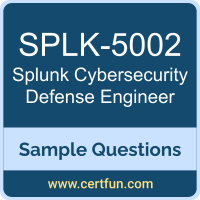 Getting knowledge of the Splunk SPLK-5002 exam structure and question format is vital in preparing for the Splunk Certified Cybersecurity Defense Engineer certification exam. Our Splunk Cybersecurity Defense Engineer sample questions offer you information regarding the question types and level of difficulty you will face in the real exam. The benefit of using these Splunk SPLK-5002 sample questions is that you will get to check your preparation level or enhance your knowledge by learning the unknown questions. You will also get a clear idea of the exam environment and exam pattern you will face in the actual exam with the Splunk Certified Cybersecurity Defense Engineer Sample Practice Test. Therefore, solve the Splunk Cybersecurity Defense Engineer sample questions to stay one step forward in grabbing the Splunk Certified Cybersecurity Defense Engineer credential.
Getting knowledge of the Splunk SPLK-5002 exam structure and question format is vital in preparing for the Splunk Certified Cybersecurity Defense Engineer certification exam. Our Splunk Cybersecurity Defense Engineer sample questions offer you information regarding the question types and level of difficulty you will face in the real exam. The benefit of using these Splunk SPLK-5002 sample questions is that you will get to check your preparation level or enhance your knowledge by learning the unknown questions. You will also get a clear idea of the exam environment and exam pattern you will face in the actual exam with the Splunk Certified Cybersecurity Defense Engineer Sample Practice Test. Therefore, solve the Splunk Cybersecurity Defense Engineer sample questions to stay one step forward in grabbing the Splunk Certified Cybersecurity Defense Engineer credential.
These Splunk SPLK-5002 sample questions are simple and basic questions similar to the actual Splunk Cybersecurity Defense Engineer questions. If you want to evaluate your preparation level, we suggest taking our Splunk Certified Cybersecurity Defense Engineer Premium Practice Test. You might face difficulties while solving the real-exam-like questions. But, you can work hard and build your confidence on the syllabus topics through unlimited practice attempts.
Splunk SPLK-5002 Sample Questions:
01. What is the primary purpose of data indexing in Splunk?
a) To ensure data normalization
b) To store raw data and enable fast search capabilities
c) To secure data from unauthorized access
d) To visualize data using dashboards
02. Which Splunk feature helps to standardize data for better search accuracy and detection logic?
a) Field Extraction
b) Data Models
c) Event Correlation
d) Normalization Rules
03. Which action improves the effectiveness of notable events in Enterprise Security?
a) Applying suppression rules for false positives
b) Disabling scheduled searches
c) Using only raw log data in searches
d) Limiting the search scope to one index
04. A company wants to create a dashboard that displays normalized event data from various sources. What approach should they use?
a) Apply search-time field extractions.
b) Implement a data model using CIM.
c) Use SPL queries to manually extract fields.
d) Configure a summary index.
05. Which methodology prioritizes risks by evaluating both their likelihood and impact?
a) Risk-based prioritization
b) Threat modeling
c) Incident lifecycle management
d) Statistical anomaly detection
06. A cybersecurity engineer notices a delay in retrieving indexed data during a security incident investigation. The Splunk environment has multiple indexers but only one search head. Which approach can resolve this issue?
a) Increase search head memory allocation.
b) Optimize search queries to use tstats instead of raw searches.
c) Implement accelerated data models for faster querying.
d) Configure a search head cluster to distribute search queries.
07. How can you ensure that a specific sourcetype is assigned during data ingestion?
a) Use props.conf to specify the sourcetype.
b) Define the sourcetype in the search head.
c) Configure the sourcetype in the deployment server.
d) Use REST API calls to tag sourcetypes dynamically.
08. What is the main purpose of incorporating threat intelligence into a security program?
a) To automate response workflows
b) To proactively identify and mitigate potential threats
c) To generate incident reports for stakeholders
d) To archive historical events for compliance
09. During a high-priority incident, a user queries an index but sees incomplete results. What is the most likely issue?
a) Buckets in the warm state are inaccessible.
b) Data normalization was not applied.
c) Indexers have reached their queue capacity.
d) The search head configuration is outdated.
10. What feature allows you to extract additional fields from events at search time?
a) Index-time field extraction
b) Event parsing
c) Data modeling
d) Search-time field extraction
Answers:
|
Question: 01 Answer: b |
Question: 02 Answer: d |
Question: 03 Answer: a |
Question: 04 Answer: b |
Question: 05 Answer: a |
|
Question: 06 Answer: d |
Question: 07 Answer: a |
Question: 08 Answer: b |
Question: 09 Answer: c |
Question: 10 Answer: d |
Note: For any error in Splunk Certified Cybersecurity Defense Engineer (SPLK-5002) certification exam sample questions, please update us by writing an email on feedback@certfun.com.
